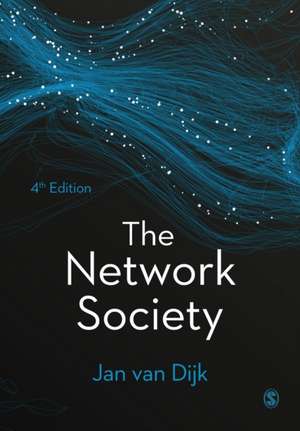The Network Society
Autor Jan A G M van Dijken Limba Engleză Paperback – 18 oct 2020
Integrating both face-to-face and online communication, the fourth edition explores crucial new issues and challenges in today’s digital media ecology, in doing so exploring the centrality of power to understanding life in the network society. Featuring:
- The rise of the ‘data economy’
- The increasing importance of artificial intelligence. big data and robotics
- The growth of Internet platforms and how to regulate big tech.
- New coverage of disinformation and fake news, including deep fake videos
- Updates to the story of digital youth culture, as a foreshadow of future new media use
| Toate formatele și edițiile | Preț | Express |
|---|---|---|
| Paperback (1) | 429.25 lei 3-5 săpt. | +31.96 lei 6-12 zile |
| SAGE Publications – 18 oct 2020 | 429.25 lei 3-5 săpt. | +31.96 lei 6-12 zile |
| Hardback (1) | 649.62 lei 3-5 săpt. | +40.70 lei 6-12 zile |
| SAGE Publications – 18 oct 2020 | 649.62 lei 3-5 săpt. | +40.70 lei 6-12 zile |
Preț: 429.25 lei
Nou
82.14€ • 85.20$ • 68.49£
Carte disponibilă
Livrare economică 06-20 martie
Livrare express 19-25 februarie pentru 41.95 lei
Specificații
ISBN-10: 1526498189
Pagini: 384
Dimensiuni: 170 x 242 x 21 mm
Greutate: 0.61 kg
Ediția:Fourth Edition
Editura: SAGE Publications
Colecția Sage Publications Ltd
Locul publicării:London, United Kingdom
Recenzii
This fourth edition of Jan A.G.M. van Dijk’s classic book, The Network Society, clarifies and analyses a wide variety of crucial concepts and contemporary practices, with insight, clarity, analysis, and critique, as well as examples, boxed explanations, and conclusions for each chapter. Topics include social values, digital media capacities, multimedia, network theory, medium theory, network society, technological foundations, platform economy, space and time, social media, digital divide, network power, privacy, digital culture, social psychology of online communication, platform regulation, intellectual property rights, global and developing network societies, and policy perspectives. This is a necessary and accessible textbook for understanding the age of digital networks.
Cuprins
Chapter 1. Introduction
A New Infrastructure of Society
A Second Communication Revolution
Characteristics of the Digital Media
Communication Capacities of Digital Media
The Nature and Design of this Book
Chapter 2. Networks: the Nervous System of Society
What is a Network Society?
A Short History of the Human Web
Networks at All Levels
Causes of the Rise of Networks
The Seven ‘Laws’ of the Web
From Mass Society to Network Society
Chapter 3. Technology
The Relationship Between Technology and Society
Technical Foundations of the Network Society
Current Technical Trends
Chapter 4. Economy
The First, Second and Third Communications Revolution
Markets, Hierarchies and Networks
Main Characteristics of a Network and Data Economy
The Network Producers: From Infrastructure to Service Providers
The Rise of a Platform Economy
Consumers: the Pushers and the Pulled
Chapter 5. Social Structure
Space and Time in the Network Society
The Blurring Spheres of Living
Social Networks and Social Media
Unity and Fragmentation: A New Social Cohesion
The Instability of the Network Society
Networks and Social (In)equality
The Digital Divide
Chapter 6. Power and Politics
What is Network Power?
Technological Power
Societal Power: Politics and Democracy
Internet: Between Freedom and Control
Power in the Organization
Privacy and Personal Autonomy
Chapter 7. Culture
What is Digital Culture?
Characteristics of Digital Culture
The Quantity and Quality of Digital Media Content
Digital Youth Culture
Trends in Digital Media Use
Chapter 8. Psychology
Perception and the Digital Media
Cognition and the Digital Media
Learning with the Digital Media
The Social Psychology of Digital Media Communication
Changes in Human Personality?
Chapter 9. Law
The Law Undermined by Networks
Who Rules the Internet?
Information and Communication Freedom
Intellectual Property Rights
The Right to Privacy
Platform Regulation
Chapter 10. Conclusions and Policy Perspectives
General Conclusions
The Network Society in North America, Europe, East Asia and the Third World
Policy Perspectives for the Network Society
Descriere
The Network Society is a clear, engaging guide to the past, consequences and future of digital communication, and forms a comprehensive introduction to how new media functions in contemporary society.
Integrating both face-to-face and online communication, the fourth edition explores crucial new issues and challenges in today’s digital media ecology, in doing so exploring the centrality of power to understanding life in the network society. Featuring:
- The rise of the ‘data economy’
- The increasing importance of artificial intelligence. big data and robotics
- The growth of Internet platforms and how to regulate big tech.
- New coverage of disinformation and fake news, including deep fake videos
- Updates to the story of digital youth culture, as a foreshadow of future new media use
With examples, cases and real-world applications, this is the essential guide for digital and new media students seeking to understand a diverse, fast-moving field.
Notă biografică
His main domains of research are the social aspects of the digital media, digital democracy and the digital divide. His best known English books are The Network Society (Four Editions, Sage Publications), Digital Democracy (2000, Sage Publications), The Deepening Divide (2005, Sage Publications), Digital Skills (2014, Palgrave Macmillan), Internet and Democracy (2018, Routledge) and The Digital Divide (2020, Polity Press). Since the year 2020 he is working on an overall work called Power & Technology, combining theories of social and natural power explaining the use of technology in human history. During his long career he was an advisory of many governments and departments as well as the European Commission.


















